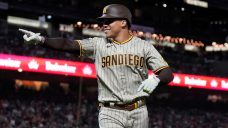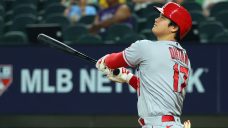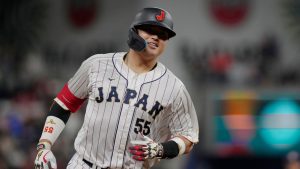NASHVILLE, Tenn. – As Shohei Ohtani continues to deliberate and the wider free-agent market awaits his decision to break from its stasis, it’s worth considering the parallels between the issues before the Toronto Blue Jays this winter and those they faced after the 2014 campaign.
You may remember how back then they were coming off a bitterly disappointing, less-than-the-sum-of-their-parts year. How their roster needed both internal recalibration and external fortification. And how their competitive window was starting to close, with their two most important players, Jose Bautista and Edwin Encarnacion, two seasons away from free agency.
Swap out Bautista and Encarnacion for Vladimir Guerrero Jr. and Bo Bichette and you have an apt description of the current moment, as well, making it relevant to reflect on what happened then when considering what’s happening now.
Because what’s at stake this off-season for the Blue Jays isn’t just the fate of 2024, but the organizational direction for multiple years beyond that, too.
Landing Ohtani, whom they remain in the mix for, would obviously be transformational, but it would also lock in a commitment to the current competitive window to try and fully leverage what’s expected to be the richest contract ever in North American pro sports.
But if Ohtani ends up with the Los Angeles Dodgers or somewhere else, acquiring another talent who legitimately extends their window beyond 2025, after which Guerrero and Bichette become eligible for free agency, will be exceptionally difficult.
And that’s true even if the Blue Jays end up with Juan Soto, which at the current San Diego Padres ask isn’t likely, since he’s a one-year play that is all about maximizing the 2024 opportunity, little else. (And as a Scott Boras client, expect him to hit free agency next year)
Other clear options available in the position-player market outside of Cody Bellinger or bringing back Matt Chapman, who both seem destined to be priced beyond Blue Jays interest, would also be shorter-term fixes that help the 2024-25 window and punt the bigger decisions about this core down the line.
Another core player could be added via creative trade, but such deals are incredibly difficult to pull off. An ability to absorb another team’s unwanted money – the way Atlanta did Sunday in taking Marco Gonzales and Evan White from the Seattle Mariners to get Jarred Kelenic for right-handers Jackson Kowar and Cole Phillips – helps, and the Blue Jays have that in their arsenal.
Still, last week when I asked Blue Jays GM Ross Atkins if he saw opportunities to add pieces that extend the club’s window or if they were more focused on pieces that leverage the current core, he acknowledged trying to do both but stressed the here and now.
"We have such an important window that we want to lean into, that we're spending a lot of time on the urgency of that roster construction, to complement it the best way,” he said.
The Blue Jays, under former GM Alex Anthopoulos during that 2014-2015 off-season, tried to thread the needle on the short and long term, trading Adam Lind for Marco Estrada, signing Russell Martin to an $82-million, five-year contract and acquiring Josh Donaldson.
Yet a massive trade deadline revamp – picking up Troy Tulowitzki, David Price, LaTroy Hawkins, Mark Lowe and Ben Revere – was still needed for them to win the AL East.
How that buildup would have played out had Anthopoulos remained to see it through is impossible to know, but Atkins was able to wring one more post-season from that group in 2016 before Encarnacion left for Cleveland. Bautista remained on a one-year deal in 2017 but was no longer the force he had been while Donaldson, Tulowitzki and Martin, who were meant to serve as the club’s new foundation, were limited by injuries and age.
With Guerrero and Bichette not timing with that core, the 2018-19 rebuild followed, opening the current cycle.
Similarly, the Blue Jays are now facing a gap beyond 2025 unless someone from a group of near-term prospects that includes Ricky Tiedemann, Orelvis Martinez, Addison Barger and Alan Roden, plus just-touched-the-majors Davis Schneider, Spencer Horwitz and Bowden Francis, emerges to bolster the current group.
The pending free agencies of Guerrero and Bichette are much more complicated than those of Bautista and Encarnacion, who hit the open market selling their age 36 and 34 seasons, not their age 27 and 28 seasons. Given the amount of peak ahead of them, re-signing them will come at considerable cost and require the fending off of other suitors.
Subtracting too heavily from their prospect base for a rental like Soto, then, would make winning sustainably even harder, which is why the read here is that the Padres’ price for him would have to drop, or they send additional pieces with more term.
Moving Alek Manoah is similarly fraught, as he has four years of contractual control remaining and even if he merely recovers enough to be a dependable back-of-the-rotation starter, let alone a Cy Young Award finalist, that helps extend the window. That’s no certainty of him doing that, however, which is why there’s a case to be made for condensing that term into immediate impact now, even if the longer-term risks are significant.
Those same principles apply to the Blue Jays’ outlook as a whole.
There is a sizable opportunity at the moment that can’t be squandered. Significant work is needed to capitalize on it in the short term. Maintaining the opportunity is even more complicated in the long term. Ohtani helps solve a lot of issues all at once but if he signs elsewhere, the stakes in other moves for the Blue Jays become much, much higher.






